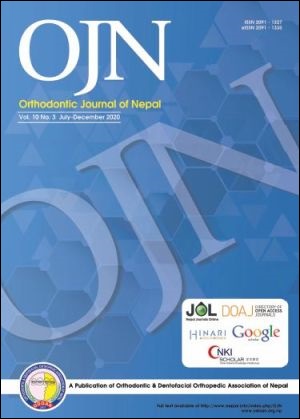Effects of debonding a conventional & customized lingual appliance on enamel structure- An invitro study
DOI:
https://doi.org/10.3126/ojn.v10i3.35485Keywords:
Chemical Cure Resin, Dual Cure Resin, Lingual appliance, Lingual orthodontics, SandblastingAbstract
Introduction: To evaluate the surface changes on enamel structure after debonding of customized and conventional lingual brackets bonded using restorative dual cure bonding material and a chemically cured bonding material with and without sandblasting.
Materials and Method: The sample consisted of 40 premolar teeth extracted for the purpose of orthodontic treatment. Enamel surface changes, prior to bonding, were studied using a stereomicroscope (Olympus SZX7) and an optical microscope. 20 extracted premolars were arranged in 2 arch forms with 5 teeth in each quadrant, after which impression of the arches with rubber base impression material was made. These impressions were then sent to the laboratory for the fabrication of a customized lingual appliance. The remaining 20 premolars were divided into 2 arches, each arch having 10 extracted premolars divided into 4 sets, 1st to test customized brackets bonded with chemical cure resin without sandblasting, 2nd to test customized brackets with dual cure resin without sandblasting, 3rd to test conventional brackets with chemical sure resin with and without sandblasting and 4th to test conventional brackets bonded with dual cure resin with and without sandblasting. The post debonding photographs were analyzed using a standardized grid and Surface Roughness Index.
Result: Thus, enamel defects are likely to be caused post debonding despite of using any combination. However, the surface roughness index has been shown to be highest post debonding in cases where customized brackets have been bonded using dual cure resin along with sandblasting.
Conclusion: While a clinician may opt for a material like Rely X U200 to bond lingual appliances in order to have a better clinical management of the appliance, but he would have to keep the possibility of irreversible damage to enamel post debonding.
Downloads
Downloads
Published
How to Cite
Issue
Section
License
Copyright © held by Orthodontic & Dentofacial Orthopedic Association of Nepal
- Copyright on any research article is transferred in full to the Orthodontic & Dentofacial Orthopedic Association of Nepal upon publication in the journal. The copyright transfer includes the right to reproduce and distribute the article in any form of reproduction (printing, electronic media or any other form).
- Articles in the Orthodontic Journal of Nepal are Open Access articles published under the Creative Commons CC BY License (https://creativecommons.org/licenses/by/4.0/)
- This license permits use, distribution and reproduction in any medium, provided the original work is properly cited.




